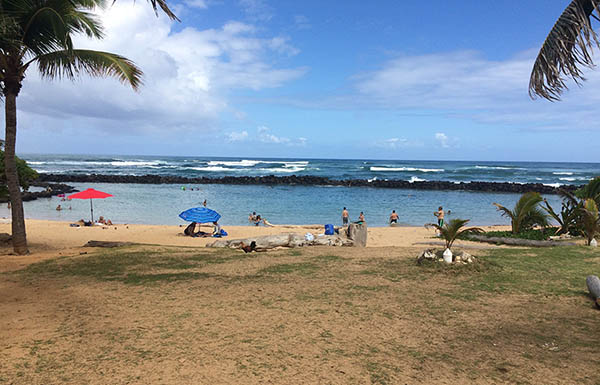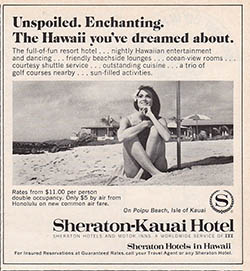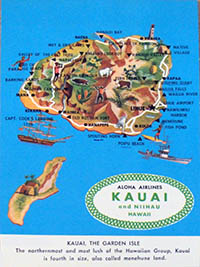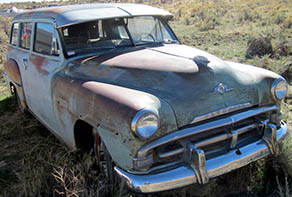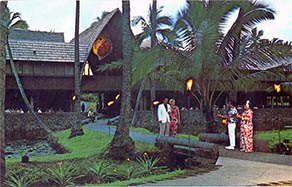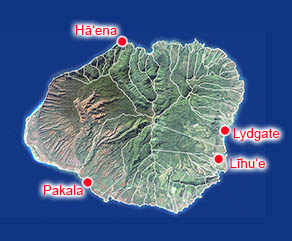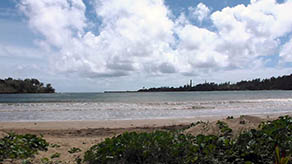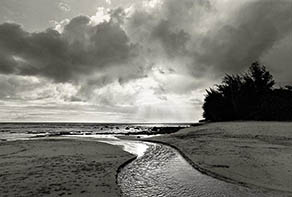 |
 |
 |
|||||
“Barney Oldfield” remembers Taylor Camp This story was submitted by one of our readers.
|
“In February of 1969 I went to Kaua‘i, Hawai‘i for two weeks. Ended up spending almost twenty years there in Hawai‘i. The state was ten years old and most of the roads were dirt roads on the outer islands. When I went surfing, I was the only guy out on a perfect six- to ten-foot day. How could I not visit for awhile? Kaua‘i had one stop light on it at that time and that ‘blinked’ yellow on all four sides. Airfare from California to Hawaii was $69.00 and inter-island airfare was $12.00 on the week days and $17.00 on the week ends. During the dock strikes and the airline strikes with the major carriers, hotel rates went down to $5.00 per night and you had to make your own bed. What a fabulous place and what a great State of the Union! Here’s how the Taylor Camp started with the intro leading up to it. “In the days of the Viet Nam war a lot of protesting was going on and there was not a shady spot in California to get away from the politics of the Nixon Era and the cloud of doubt that hung over our great country regarding that war: the heroin trade, the CIA, Black Ops, the Kent State massacre and the rest of the fear and doubt of that time. I was living with some friends in Big Bear, California—Preston and Mary Rush—who wanted to sell their Big Bear cabin in Sugarloaf and go to Kaua‘i for a few months. Sounded like a pretty good idea and I decided to join them, and a few other close high school friends that tagged along. “I was solo and one of the last of seven in our group of friends that got to Kaua‘i. And when I did, I found that Līhu‘e airport was thirty-five miles from where they were staying in Hā‘ena, at the northern end of the road on that island. It took all day to hitch-hike, as there were not a lot of people living on that island in 1969. There was one main road that went around the island and that road could be driven in about an hour’s time. Because of the Na Pali Coastline, that road was not able to tie back into itself, leaving a horseshoe-like road for island travel. At the north western end of the road was Barking Sands Beach which had an annual rainfall of three inches, and at the opposite end of the road was Mount Waialeale with its torrential averages and massive 1500 ft waterfalls that numbered seventeen and over on her face during some of her wetter years. “Most of the population had been there all of their lives and I had met many that were in their later years and had never been off the island. Some of the older men that worked for the county rode horseback with pack mules and their jobs were to go back into the deep valleys to remove the dead carcasses of the animals which had died in the valley streams, causing high bacteria levels in the county's water reservoirs. I believe that the population was just under 39,000 residents and most worked either in the tourist industry or the sugar cane industry, which was not a growing industry any longer due to cheaper cane processing on other Pacific Islands. “According to a map that I was sent and a phone number that I was given, the person that was my go-to guy in hooking up with my people was a ‘Bob Corneal.’ Bob was about 65 years young and had a plantation home just south of the wet caves in Hā‘ena. He told me that my people were in tents in the beach park in Hanalei, about five or six miles or so, south of where Bob was living. “A day later I hooked up with my friends at the beach park and found that they had hooked up with a few others from San Francisco, Sandy and Victor Schaub were two of them. Victor was a Berkley graduate and was a California licensed Attorney. Sandy was looking for a job at one of the few hotels on the island. They had their little girl, Heidi with them and she was a kick in the pants, bright and cheery and she took no prisoners when she would get teased. No one messed with Heidi. “That same day it started to rain and it rained for eleven days in a row. Nearly non-stop. On the twelfth day it was beautiful and the day after that it started to rain again for nine days in a row. The rain was warm but wet. Everything I had brought was damp. We all had some money so food wasn’t an issue with the Hanalei store just down the road. Because of all the rain and the location and the stories that we heard about Mount Wai‘ale‘ale being the mountain which backs up Hanalei and one of the most consistent wettest spots on earth, I decided to scout the Island and find a dryer place to live. Victor had an old ‘52 Plymouth and we used that when we needed wheels. Gas was 75 cents per gallon, beers were 50 cents and they opened them for you at the local stores if you wanted them to. “After hitch-hiking around the island and coming up with a few campgrounds just north of Līhu‘e in Wailua, I was able to get ahold of my people somehow and let them know about Lydgate Park, which was a beach park on the opposite side of Coco Palms Hotel. Victor knew about Lydgate Park and was all ready to change locales for a drier camping area. Either way, didn’t matter. This State Park was laced with long-needle pine trees, from the beach up to the highway and that was about 400 yards with lots of ironwood and palms spotting the park, throughout. This was a campers’ paradise and it had pavilions in it with barbeques, rest rooms, outside showers (water is 74 degrees) and electricity and sheltered, benched eating areas and no one else was in the park, only us. There was no deadline on how long we could stay, only the Park Rules and they were the ‘Keep your Park clean’ type of rules. This was a paradise park in paradise and someone else paid the utilities. “This is where we set up the tents and by now there were thirteen of us living in those tents. The County did not require any permits (at that time) and there were no State or County laws that we were in violation of. After all, if and when something did occur, we had our own attorney right there on hand to make sure our rights were not violated, we all felt reassured about that. The Park was surrounded by a golf course and at the top of the course was the Coco Palms Hotel. Along side the Hotel ran the Wailua River and there were house lots on the banks of the river. I had made a friend with one of the residents that lived in one of the cabins, in those house lots and I stayed there often when I got tired of the mosquitos gnawing on my ears at night outside and in the tents. “We lived at Lydgate Park for three to four months. Sandy Schaub got a job at the Coco Palms hotel main restaurant and food was no problem, as what was left over from all the tourist luaus, supplied us daily with enough food and grog and then some. “What we didn’t know about and what we didn’t expect was Lionel Robinson. Lionel Robinson owned more than half of the island of Kaua‘i and he owned the entire island of Ni‘ihau (population 300 in 1969) and he had a great deal of political clout. Lionel had a plantation home on the Kōloa side of the island on one of the finest mile-long beaches (still does) on the island. In front of his palatial plantation estate was the surf spot called Pakala which the surfers called ‘Infinities.’ He was obsessed with kicking off surfers from his island but he had trouble with his wife for she adored them. After her death in ‘68-‘69, things changed and Robinson’s men were often seen at the mouths of the rivers, which bordered his plantation property, throwing in cow guts to draw the hammerhead sharks to keep the surfers from getting to the surf site. “If you really wanted to surf Pakala’s, you had to paddle down the Hanapepe river to the mouth of it and then paddle a half mile down to the sandy beach where you could walk another half mile to surf those infinite and perfect, south shore breaking waves. Once you were on a beach, you could walk that beach, sleep on that beach and even live on it up to the vegetation line (according to State Law), for the people of Hawai‘i owned the beaches then and still do. Only other way to gain access to that surf spot was to trespass on the Robinson's land and if one did that and got caught, then the surfboard would be confiscated and one of Lionel's men would escort the trespasser to the airport and threaten jail time if he ever came back to the island again.. “When Lionel Robinson heard that there were squatters (hippies) living in Lydgate Park, he got the then-district attorney, Eduardo Malapit (who later became Mayor of Kaua‘i) to craft up a restraining order and had us booted out of Lydgate Park. By the time we got back, by way of Victor’s legal magic, the State and County had developed park permits with fees and stay restrictions. We all packed up and headed a few miles south to Hanamaulu Park and pitched our tents. Everything was fine for a week or so then the local police showed up and told us that we either had to leave or they were going to take us to jail. Well, we knew where the old jail was and it was sorta neat and it was right across from—yup, you got it—Lydgate Park. Looked like the old Alamo and was set off the highway just a bit. Everyone decided to go to jail and see how the county liked putting up with the thirteen of us. “The jail was old and the proprietor was about 80 years old and his name was Cruz. He said that there were no keys to the jail or the cells, they had been lost years ago, not too long after the war. There was one person ‘in jail’ and he was an old Filipino who had killed a couple of Japanese sugar cane workers the day that Pearl Harbor was bombed. He had no family and no friends so he ‘sorta lived’ at the jail and Cruz took care of him. 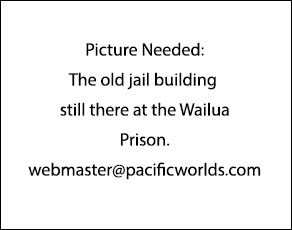 “Kaua‘i Police Chief, Dewey Allen, completely bewildered at the idea of people actually wanting to go to jail, acquired black-and-white-striped uniforms for all the new hippie inmates. I don’t recall if Heidi ever got one or if there was one that was ever made for her. Anyway, twelve of the thirteen decided to go to jail, I was the only one that decided not to go—after all, someone had to be the outside guy and make sure that no one went without needs. And why should I go when I could stay right up the road in Wailua at the house lots? I visited every day and when I did, I would find the twelve as happy as can be, three square meals a day and a hot shower and a roof over their heads and, that’s right: NO KEYS to lock them in. Even though they were not allowed to leave the jails grounds (eight acres) they would be outside planting flowers and vegetables and the like and playing music on guitars and harmonicas, etc. 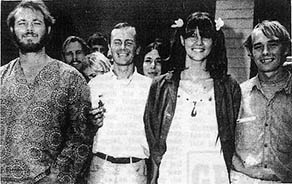
“Well, the local paper The Garden Isle and the Honolulu Advertiser as well as the Honolulu Star Bulletin, all heard about this and took some pictures and did some personal interviews and after front page publicity struck the islands, tourists from all over were coming over to Kaua‘i and looking for the jailed ‘Lydgate Hippies’ that were imprisoned for camping at a State Park. They came by the droves and came offering money, food, clothing, credit cards, rental cars, bail money. No one could believe that anyone would incarcerate a little four-year-old girl...and the flack flew. Bail was set at $2.00 each but no one would pay it so Dewey Allen asked Malapit to drop the bail and Malapit dropped it to $1.00 but still no one would pay it. "And then the island residents got involved and flipped out—and so did Lionel Robinson. I think Lionel at this time was ready to throw everyone off his island. This man had some very heavy clout and he knew how to use it. When he did, there was our Victor Schaub, threatening injunctions and the like, legally stopping every move that Lionel tried to make. Since the media was now involved, nothing was hidden and every move that Robinson made was under the bright lights. “It started getting real nasty and they started talking about a new jailer and keys and locks and the State losing some of their expired land leases from the Robinson clan. And then, all of a sudden, this angel by the name of Howard Taylor came by the jail. He might just as well had had wings and been dressed all in white, because he offered these poor victims his 2.5 acres of beach front property at the end of the road in Hā‘ena to pitch their tents on. Not only was Lionel furious about not being able to do squat about the squatters and get us off his island, but now he had one of the movie industry’s brightest stars’ brother and her children in Kaua‘i's laid-back spotlight, and the media was just loving it. “Howard Taylor was Elizabeth Taylor’s brother. He was a burly, robust, happy and wonderfully natured person and an oceanographer. His wife Mara was outgoing, warm and so very friendly to all and I was fortunate to get to know them personally along with their wonderful family. His children were Tommy, Chris and Layton. At that time, Howard was taking care of Elizabeth’s two sons, Michael and Christopher Wilding. Chris was 14 and Michael was 18. There would not be a hole deep enough for Lionel to put his head in or a porch cold enough for him to sleep on, if he started in on the Taylor kin. “Howard had a bulldozer on the 2.5 acres and we used it a little to clear the iron wood from the tent areas. We dug deep potty holes and used lye every day that it was in use. The spear fishing was great and the local valleys were bursting with jack fruit, guava, papaya, mango, and strawberry mangos, lychee and a great deal more. ‘Opihi and fresh shrimp in the streams and even turtle was legal to catch and turtle meat is delicious. “There was a twelve-mile trail just up from the camp that trekked to Kalalau valley and the Valley of the Lost Tribes. This trail was unkept and the five or six times I made the hike into it, I had to take a machete with me to clear parts of the switch backs which laced the crags and cliff ridges at least 10 of the 12 miles. Two miles in on the twelve-mile trail is Hanakapi‘ai beach and the second time I was there, was just after a couple of Robinsons paniolos (cowboys) had been there to kill some wild pigs or goats or both and throw them upstream in the valley streams and creeks to pollute the waters and keep the Taylor Camp people and others out of and away from even thinking about camping in Kaua‘i’s lush inner valleys. The cops thought that we were planting pakalolo (pot) back in the valleys, but we weren't. Maybe other solo growers were growing it but the island was not trekked then and we were all over it. If someone was new and wandering, one of us would run into them somewhere. 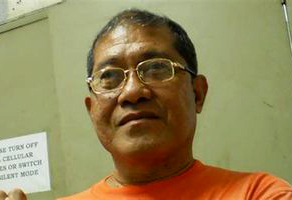
Eduardo Malapit. “Howard Taylor and family were in a rental house on Hā‘ena Road, about 1.5 miles south of the Taylor camp and I visited him and the kids all the time that I was up around the camp and not hiking or exploring the island. I was 22 years old and I wanted to experience it all. One day Victor Schaub and a few of us from the camp and Michael Wilding and a Taylor or two went into Kapa‘a for some marketing and decided to go to pick some pineapples from an old abandoned pineapple field that Hawaiian Fruit Packers had used for growing pineapples behind Kapa‘a, but since it was cheaper and more economical to do it in the Philippines, they closed down their Pineapple division in Kaua‘i and moved on. Hawaiian Fruit Packers was a division of ‘The Hawaii Corporation’ owned by its founder and CEO, Senator Randy [Randolph A.] Crossley (R, Hi). “Well, one of the local cops in his private car followed us and busted us with eighty-five pounds of pineapple. They took the pineapple and our names and guess what? Lionel wanted us in prison for it, so the Kaua‘i police department, under the authority of Malapit, issued warrants for six of us and had the bail set at $2.00 each. They took us in and booked us and even though we had the money, we wouldn't pay the bail, so they dropped it to a buck. Since we still wouldn't pay it, this time, instead of taking us back to the jail, they paid it themselves. 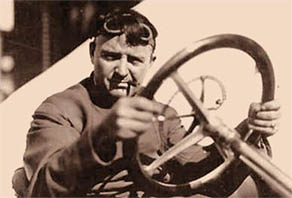
“We went to court and Lionel Robinson had the District Attorney Eduardo Malapit begging the judge for jail time and heavy fines and with the recommendation that they kick us all off the island. The judge (Japanese-Hawaiian) was almost in tears he was laughing so hard, ended up imposing a fine of five cents a pound on the eighty-five pounds of pineapple and ordered us to pay the DA, or do the time in jail. "We wouldn't pay it. The DA paid the $4.25 and begged us to stay out of trouble. Howard Taylor was in court that day and it is a day that he will never forget. I had a nickname of Barney Oldfield. In high school I had a lot of cars and loved to drag race. Barney Oldfield was Henry Ford’s test-car driver and that’s how I got the nickname of ‘Barney.’ When the cops asked the Taylor kids in the pineapple field who I was (I had no ID with me) they said, ‘He’s Barney Oldfield.’ That's the name that I was booked under and that is the name that the DA used in court that day when we were all defendants in the pineapple fiasco. “Howard went on to buy a nice piece of property just off the driveway of Bob Corneal there in Hā‘ena just past the vegetation line on a beautiful bay. I helped him a few days on the building of his house and by some quirk of bad luck I got a staph infection which went from bad to worse. Howard drove me to the hospital in Līhu‘e and actually carried me into the hospital for treatment. He also paid for the hospital visit and to this day I know that he saved me from a very bad consequence. “In the summer of ‘69 I was able to hitch a ride from Hanalei Bay, Kaua‘i, to the Ala Wai Yacht Harbor in Honolulu, where I lived for six years. The Taylor Camp went on to attract a lot of transient people and dopers, from what I heard. After I left Honolulu I moved to Maui for about thirteen years. I had to laugh when I would run into people who said that they were one of the first in the Taylor Camp. If they didn’t know Barney Oldfield, they were not one of the first. "I still am in contact with some of the others that were at the get-go and some of the names are as follows:
“One of the original thirteen was a little guy from Iowa and he was a nutritionist and a baker. In the middle of the Taylor Camp, he dug a hole and made an oven out of lava rock and baked the most perfect loaf of ‘Indian Health Bread’ that I have, to this day, ever eaten. “Hope this sets the story straight.”
|
